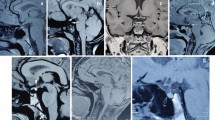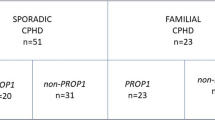Abstract
Purpose
There is limited data regarding Pituitary Stalk Interruption Syndrome (PSIS) from India. Moreover, the pathophysiological link between perinatal events and PSIS is unclear. We aim to elucidate the predictors of PSIS among patients with growth hormone deficiency (GHD) and perinatal events in PSIS by comparing cohorts of PSIS and genetically proven GHD without PSIS.
Methods
Among 179 GHD patients, 56 PSIS and 70 genetically positive GHD (52-GHRHR, 15-POU1F1, and 3-PROP1) patients were included. Perinatal events, clinical anomalies, pituitary hormone deficiency, and imaging findings were recorded. We compared PSIS-isolated GHD (PSIS-IGHD) subgroup with GHRHR-IGHD and PSIS-combined pituitary hormone deficiency (PSIS-CPHD) subgroup with POU1F1/PROP1-CPHD.
Results
PSIS patients (45 males, median age: 12.5 years) most commonly presented with short stature. At last follow-up (median age: 17.35 years), gonadal (during pubertal-age), thyroid and cortisol axes were affected in 81.6%, 62.5%, and 62.5%. 10/13 (77%) of PSIS children with initial IGHD diagnosis manifested hypogonadism during pubertal age. Male predominance, sporadic presentation, and clinical anomalies were significantly higher in both PSIS subgroups than in the respective genetic subgroups. Breech presentation was higher in PSIS-CPHD than POU1F1/PROP1-CPHD (44.4% vs 5.5%, p = 0.004). Neonatal hypoglycemia (22% vs. 0%, p = 0.05) and jaundice (42 vs. 5%, p = 0.004) were higher in PSIS-CPHD than PSIS-IGHD.
Conclusion
Later age at presentation and frequent hypogonadism were observed in our PSIS cohort. Male sex, sporadic presentation, clinical anomalies, and breech presentation predicted PSIS at presentation. Breech presentation in PSIS is likely due to stalk interruption rather than hormonal deficiency.
Similar content being viewed by others
References
Vergier J, Castinetti F, Saveanu A et al (2019) Pituitary stalk interruption syndrome: etiology and clinical manifestations. Eur J Endocrinol 181:R199–R209. https://doi.org/10.1530/EJE-19-0168
Rottembourg D, Linglart A, Adamsbaum C et al (2008) Gonadotrophic status in adolescents with pituitary stalk interruption syndrome. Clin Endocrinol (Oxf) 69:105–111. https://doi.org/10.1111/j.1365-2265.2007.03155.x
Zwaveling-Soonawala N, Alders M, Jongejan A et al (2018) Clues for polygenic inheritance of pituitary stalk interruption syndrome from exome sequencing in 20 patients. J Clin Endocrinol Metab 103:415–428. https://doi.org/10.1210/jc.2017-01660
Fang X, Zhang Y, Cai J et al (2020) Identification of novel candidate pathogenic genes in pituitary stalk interruption syndrome by whole-exome sequencing. J Cell Mol Med 24:11703–11717. https://doi.org/10.1111/jcmm.15781
Brauner R, Bignon-Topalovic J, Bashamboo A, McElreavey K (2020) Pituitary stalk interruption syndrome is characterized by genetic heterogeneity. PLoS ONE 15:1–19. https://doi.org/10.1371/journal.pone.0242358
Guo QH, Wang CZ, Wu ZQ et al (2017) Multi-genic pattern found in rare type of hypopituitarism: a whole-exome sequencing study of han chinese with pituitary stalk interruption syndrome. J Cell Mol Med 21:3626–3632. https://doi.org/10.1111/jcmm.13272
Pinto G, Netchine I, Sobrier ML et al (1997) Pituitary stalk interruption syndrome: a clinical-biological-genetic assessment of its pathogenesis. J Clin Endocrinol Metab 82:3450–3454. https://doi.org/10.1210/jc.82.10.3450
Simon D, Hadjiathanasiou C, Garel C et al (2006) Phenotypic variability in children with growth hormone deficiency associated with posterior pituitary ectopia. Clin Endocrinol (Oxf). https://doi.org/10.1111/j.1365-2265.2006.02484.x
Melo ME, Marui S, Carvalho LR et al (2007) Hormonal, pituitary magnetic resonance, LHX4 and HESX1 evaluation in patients with hypopituitarism and ectopic posterior pituitary lobe. Clin Endocrinol (Oxf) 66:95–102. https://doi.org/10.1111/j.1365-2265.2006.02692.x
Chen S, Léger J, Garel C et al (1999) Growth hormone deficiency with ectopic neurohypophysis: anatomical variations and relationship between the visibility of the pituitary stalk asserted by magnetic resonance imaging and anterior pituitary function. J Clin Endocrinol Metab 84:2408–2413. https://doi.org/10.1210/jcem.84.7.5849
Dutta P, Bhansali A, Singh P et al (2009) Congenital hypopituitarism: clinico-radiological correlation. J Pediatr Endocrinol Metab 22:921–928. https://doi.org/10.1515/JPEM.2009.22.10.921
Kulkarni C, Moorthy S, Pullara S et al (2012) Pituitary stalk transection syndrome: comparison of clinico-radiological features in adults and children with review of literature. Indian J Radiol Imaging 22:182–185. https://doi.org/10.4103/0971-3026.107179
Jadhav S, Diwaker C, Lila AR et al (2021) POU1F1 mutations in combined pituitary hormone deficiency: differing spectrum of mutations in a Western-Indian cohort and systematic analysis of world literature. Pituitary 24:657–669. https://doi.org/10.1007/s11102-021-01140-9
Grimberg A, Divall A, Allen DB (2016) Hormone research in guidelines for growth hormone and insulin-like growth factor-I treatment in children and adolescents: growth hormone deficiency, idiopathic short stature, and primary insulin-like growth factor-I deficiency. Horm Res Paediatr 19104:361–397. https://doi.org/10.1159/000452150
Jagtap VS, Acharya SV, Sarathi V et al (2012) Ectopic posterior pituitary and stalk abnormality predicts severity and coexisting hormone deficiencies in patients with congenital growth hormone deficiency. Pituitary 15:243–250. https://doi.org/10.1007/s11102-011-0321-4
Chilton LA, Dorst JP, Garn M (1983) The volume of the seila turcica in children : new standards. AJR 140:797–801. https://doi.org/10.2214/ajr.140.4.797
Kale S, Gada JV, Jadhav S et al (2020) Genetic spectrum and predictors of mutations in four known genes in asian indian patients with growth hormone deficiency and orthotopic posterior pituitary: an emphasis on regional genetic diversity. Pituitary 23:701–715. https://doi.org/10.1007/s11102-020-01078-4
Bar C, Zadro C, Diene G et al (2015) Pituitary stalk interruption syndrome from infancy to adulthood: clinical, hormonal, and radiological assessment according to the initial presentation. PLoS ONE 10:1–12. https://doi.org/10.1371/journal.pone.0142354
Wang W, Wang S, Jiang Y et al (2015) Relationship between pituitary stalk (PS) visibility and the severity of hormone deficiencies: PS interruption syndrome revisited. Clin Endocrinol (Oxf) 83:369–376. https://doi.org/10.1111/cen.12788
Wang F, Han J, Shang X, Li G (2019) Distinct pituitary hormone levels of 184 Chinese children and adolescents with multiple pituitary hormone deficiency: a single-centre study. BMC Pediatr 19:1–9. https://doi.org/10.1186/s12887-019-1819-6
Wang Q, Hu Y, Li G, Sun X (2014) Pituitary stalk interruption syndrome in 59 children: the value of MRI in assessment of pituitary functions. Eur J Pediatr 173:589–595
Pham LL, Lemaire P, Harroche A et al (2013) Pituitary stalk interruption syndrome in 53 postpubertal patients: factors influencing the heterogeneity of its presentation. PLoS ONE. https://doi.org/10.1371/journal.pone.0053189
Guo Q, Yang Y, Mu Y et al (2013) Pituitary stalk interruption syndrome in Chinese people: clinical characteristic analysis of 55 cases. PLoS ONE. https://doi.org/10.1371/journal.pone.0053579
Fernandez-Rodriguez E, Quinteiro C, Barreiro J et al (2011) Pituitary stalk dysgenesis-induced hypopituitarism in adult patients: prevalence, evolution of hormone dysfunction and genetic analysis. Neuroendocrinology 93:181–188. https://doi.org/10.1159/000324087
Deal C, Hasselmann C, Pfäffle RW et al (2013) Associations between pituitary imaging abnormalities and clinical and biochemical phenotypes in children with congenital growth hormone deficiency: data from an international observational study. Horm Res Paediatr 79:283–292. https://doi.org/10.1159/000350829
Hofmeyr GJ, Hannah M, Lawrie TA (2015) Planned caesarean section for term breech delivery. Cochrane Database Syst Rev. https://doi.org/10.1002/14651858.CD000166
Adamkin DH, Papile LA, Baley JE et al (2011) Clinical report—postnatal glucose homeostasis in late-preterm and term infants. Pediatrics 127:575–579. https://doi.org/10.1542/peds.2010-3851
Mauvais FX, Gonzales E, Davit-Spraul A et al (2016) Cholestasis reveals severe cortisol deficiency in neonatal pituitary stalk interruption syndrome. PLoS ONE 11:1–12. https://doi.org/10.1371/journal.pone.0147750
Grammatikopoulos T, Deheragoda M, Strautnieks S et al (2018) Reduced hepatocellular expression of canalicular transport proteins in infants with neonatal cholestasis and congenital hypopituitarism. J Pediatr 200:181–187. https://doi.org/10.1016/j.jpeds.2018.05.009
Kandemir N, Yordam N, Cila A, Besim A (2000) Magnetic resonance imaging in growth hormone deficiency: relationship between endocrine function and morphological findings. J Pediatr Endocrinol Metab 13:171–178. https://doi.org/10.1515/JPEM.2000.13.2.171
Maghnie M, Larizza D, Triulzi F et al (1991) Hypopituitarism and stalk agenesis: a congenital syndrome worsened by breech delivery? Horm Res 35:101–108. https://doi.org/10.1159/000181883
Otto AP, França MM, Correa FA et al (2015) Frequent development of combined pituitary hormone deficiency in patients initially diagnosed as isolated growth hormone deficiency: a long term follow-up of patients from a single center. Pituitary 18:561–567. https://doi.org/10.1007/s11102-014-0610-9
Tanriverdi F, De BA, Bizzarro A et al (2008) Antipituitary antibodies after traumatic brain injury: is head trauma-induced pituitary dysfunction associated with autoimmunity ? Eur J Endocrinol. https://doi.org/10.1530/EJE-08-0050
De BA, Kelestimur F, Sinisi AA et al (2008) Anti-hypothalamus and anti-pituitary antibodies may contribute to perpetuate the hypopituitarism in patients with Sheehan’s syndrome. Eur J Endocrinol. https://doi.org/10.1530/EJE-07-0647
Funding
The authors did not receive any financial support for the submitted work.
Author information
Authors and Affiliations
Contributions
CD and PT contributed equally as first author. ARL conceived the presented idea. CD and PT collected and analyzed the data with the help of SSM, MK, and BK. CD and SSM wrote the manuscript in consultation with VS, ARL, TB, NS and VP. Genetic analysis was done by SA. Final version of the manuscript was checked by all authors.
Corresponding author
Ethics declarations
Conflict of interest
The authors have no conflict of interest to declare that are relevant to the content of this article.
Participant's informed consent
This was a retrospective study approved by the Institutional ethics committee with a waiver of consent.
Additional information
Publisher's Note
Springer Nature remains neutral with regard to jurisdictional claims in published maps and institutional affiliations.
Supplementary Information
Below is the link to the electronic supplementary material.
Rights and permissions
About this article
Cite this article
Diwaker, C., Thadani, P., Memon, S.S. et al. Pituitary stalk interruption syndrome: phenotype, predictors, and pathophysiology of perinatal events. Pituitary 25, 645–652 (2022). https://doi.org/10.1007/s11102-022-01243-x
Accepted:
Published:
Issue Date:
DOI: https://doi.org/10.1007/s11102-022-01243-x




